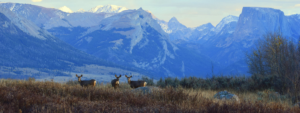In a win for rural America and fish and wildlife habitat, these changes will help pull the CRP out of an enrollment slump and better support farmers and ranchers who want to incorporate conservation into their business plans
Yesterday afternoon, the U.S. Department of Agriculture announced several long sought after changes to the Conservation Reserve Program that will help boost shrinking enrollment in our nation’s most popular private lands conservation program. Currently, the program sits 4 million acres below the 25-million-acre cap, with another 9 million CRP acres expiring between now and the 2023 Farm Bill.
Yesterday’s announcement is a strong first step in addressing changes to program administration that accelerated this decline to a historic three-decade low. Six provisions that will support the enrollment and re-enrollment of valuable habitat for decades to come include:
Restoring the use of soil productivity as an adjusting factor in soil rental rate calculations. This reverses a June 2018 decision that led to significantly decreased rental rate offerings on highly productive soils and widely varying rates across county lines. Taking soil productivity into account will ensure these rates more accurately reflect county-wide averages and provide consistency—landowners looking to re-enroll in the program should not be met with rental rate offerings well below what they’ve historically received.
Creating a new incentive for climate-friendly conservation practices. A new carbon incentive will provide an additional 3 to 10 percent on top of base soil rental rates for practices that combat climate change. The CRP can be a valuable tool for sequestering more carbon, and most practices will qualify for this incentive. At the same time, better soil quality equates to better habitat and fewer impacts of climate change on fish and game.
Increasing incentives for particularly high-quality conservation practices. The Farm Service Agency provides Practice Incentive Payments to alleviate the cost burden on CRP landowners who make top-quality habitat improvements, control erosion, or enhance water quality on acreage under Continuous CRP. (The Continuous program targets practices on environmentally sensitive lands and is not subject to a competitive bidding process like General CRP. Plus, landowners can enroll year-round and not just during a sign-up event.) These incentives were lowered to 5 percent in recent years, then increased to 20 percent in December 2020. Yesterday’s announcement increases these payments to 50 percent of the cost of putting conservation on the ground.
Boosting incentives for practices that help high-priority local wildlife by administering the State Acres for Wildlife Enhancement (SAFE) initiative through Continuous CRP. SAFE facilitates state and local involvement in the development of practices that safeguard particularly at-risk wildlife. In late 2019, SAFE was moved from the Continuous CRP umbrella to the general sign-up, which limited rental rates and signing and practice incentives, lowering landowner interest. Moving the high-value SAFE practices back to the Continuous program restores benefits that will ensure conservation-minded landowners can make an impact for wildlife.
Removing limitations on long-term efforts to improve clean water. The Clean Lakes Estuaries and Rivers (CLEAR) 30 pilot program was created in the 2018 Farm Bill and supports the establishment of 30-year CRP water quality practices. The bill did not place a geographic restriction on the program, but a June 2020 announcement limited its availability to 12 states in the northeast and Midwest. This week’s announcement makes the pilot available to landowners across the country.
The USDA also announced it would increase CRP technical assistance funds at the Natural Resource Conservation Service to $140 million, which will support soil sampling to determine a baseline standard for carbon sequestration within the CRP.
Several of these updates reflect recommendations shared by the TRCP and partners in recent years, as sportsmen and women have urged administration officials to restore the purchasing power of the CRP, which Congress saw fit to expand in the last Farm Bill. Creating a more healthy CRP and providing its full suite of benefits to wildlife and landowners was also among the TRCP’s top ten conservation priorities for the Biden administration’s first 100 days.
The course correction for CRP follows an announcement in February that the Farm Service Agency would be extending the ongoing general sign-up period to allow for a thorough evaluation of the tools available to interested landowners. The TRCP and several partner organizations have been supportive of this process and are encouraged by the outcome.
As we look to the 2023 Farm Bill, a healthy CRP is important to rural America for so many reasons. Beyond healthy soil and water, quality habitat and carbon sequestration, CRP acreage provides landowners and local communities with economic opportunities that extend well beyond the farm. Further, as Congress and the USDA look to prioritize carbon sequestration and climate resilience into federal decision-making, landowners, farmers, and ranchers must have seat at the table. A strong Conservation Reserve Program offers just that.
A full breakdown of what’s included in the FSA announcement is available here.
To learn more about the benefits of farm bill conservation programs, click here.
Image courtesy of the U.S. Fish and Wildlife Service







Improvements to the CRP program are welcomed and overdue. The constant manipulation of conservation lands and policies are detrimental to public and private concerns.
I am 75 and hunt pheasants in South Dakota, Ducks & Geese here in Missouri were I live, and Archery Elk hunt in Colorado. We need more land to hunt but we need more Habitat 1st, CRP land.
In our area duck and other wildlife habitat need improving. I have CRP, CREP sites the latter for wildlife but the adjacent area can be improved by conversion to a pond. Would be interested in seeing what your service can do. Thank you
A great win indeed! I am glad that these changes aid the CRP out of an enrollment slump. I am also happy to hear that it helps farmers and ranchers as well, who want to incorporate conservation into their business plans. Out here in Nevada we have a lot of farmers that can greatly benefit from this kind of change. Thanks!
I am 81 years old and I signed up to renew my CP17A(living snow fence), CP37(duck nesting) last fall 2020 because I did not want to turn 70 acres of good habitat black again. Now six months later I find out I will lose over $10,000. in rental payments over the 10 year contract. Also no mid contract maintenance for burning etc. another lose of approx. $5000. for burning. Seems that those contracts signed last fall should be grandfather to these new rules. Had I been younger I would have turned it black but now I would be 85 or older before having good habitat again, even if I got back in the program within a year or so. Trying to help the birds and bees and now I have to take it in the shorts due the previous administrations not caring about anything but big AG., Chem. etc. No upland Birds in DC. I have been in CRP programs on my farms since 1989 and this is the first time I may regret resigning. Thank God we now have an administration that cares for our planet and the critters that call it home.
So what is the USDA, FSA, NRCS going to do for those of us who renewed our CRP contracts under the Trump (big AG) administration. We now have a Democratic administration with a focus on the environment and conservation and, with Sec. Vilsack leading the changes, rental rates are rising to the level they should be at.